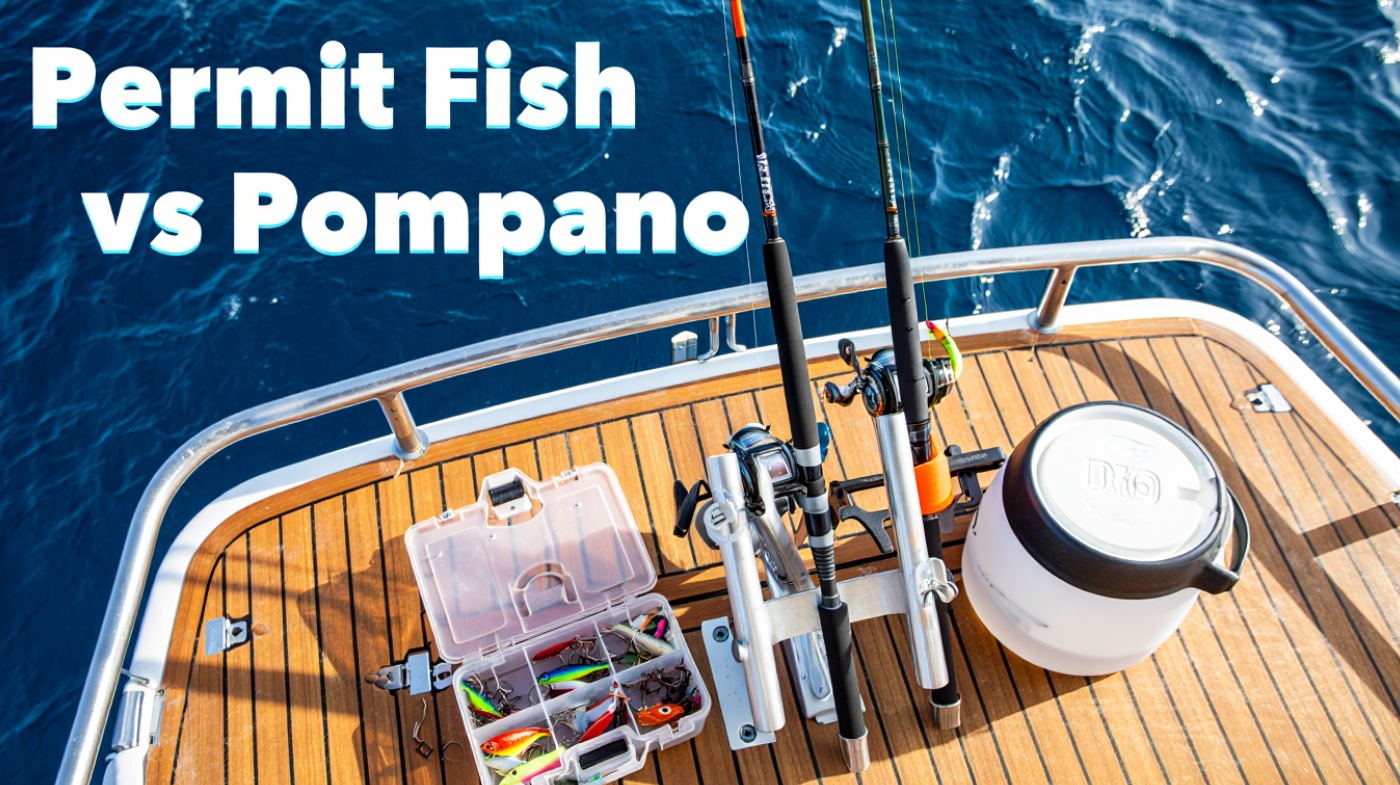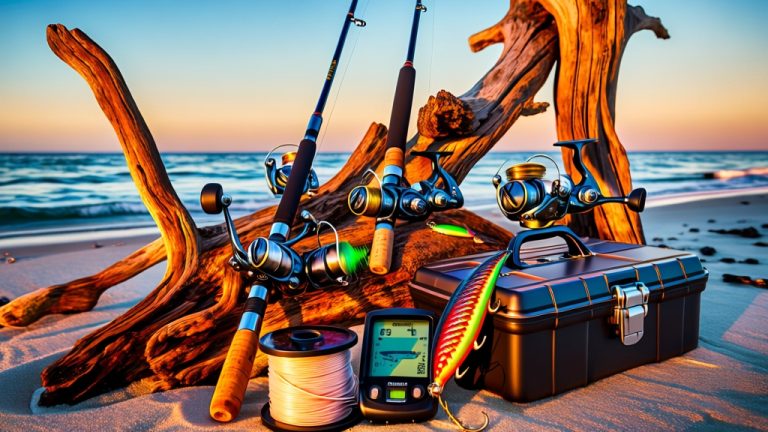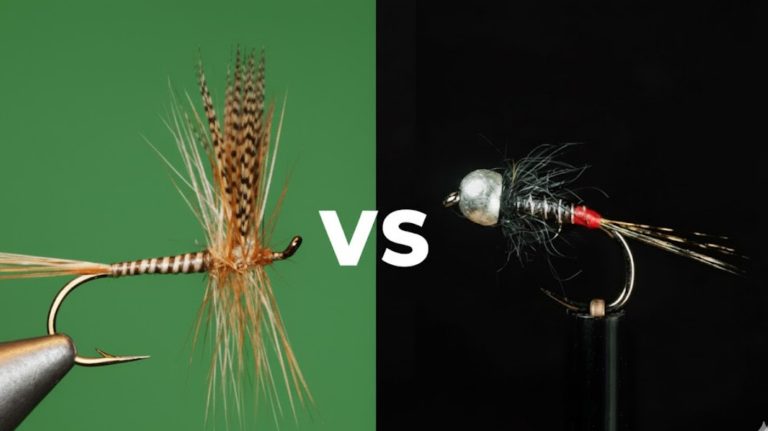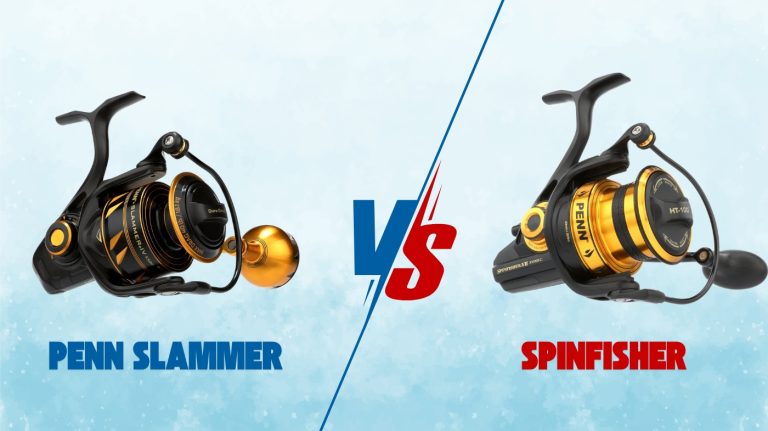Permit Fish vs Pompano: Everything You Need to Know
You’ll notice permit fish are much larger, often 25-30 pounds versus pompano’s 1-3 pounds. They are bulkier with darker, spotted bodies and longer fins.
Pompano have a streamlined, silvery shape with yellowish fins. Both share warm coastal waters, but permit favor shallower flats and migrate seasonally, while pompano stay near surf zones.
Their diets differ slightly, and fishing them requires distinct gear and tactics. Understanding these differences enhances your angling success and fish handling skills.
More nuanced insights await your exploration.
Key Takeaways
- Permit are larger, bulkier fish (25-30 lbs) with black spots and a dark line under the eye, while pompano are smaller (1-3 lbs) and silver with yellow fins.
- Permit prefer shallow flats and seagrass beds, migrating seasonally; pompano inhabit surf zones and estuaries year-round with localized movements.
- Permit feed on crustaceans and mollusks using powerful crushing plates; pompano target small, soft benthic invertebrates like shrimp and crabs.
- Permit require heavy tackle and stealthy, precise casting; pompano fishing uses lighter gear with quick retrieves near surf zones.
- Proper identification and handling differ: permit have longer fins and larger mouths, pompano have shorter fins and streamlined bodies, both need gentle release.
Fish Comparison Table: Permit and Pompano
| Feature | Permit Fish | Pompano |
|---|---|---|
| Average Size | 24–48 inches | 12–18 inches |
| Weight Range | 25–30 lbs (records >60 lbs) | 1–3 lbs (rarely up to 8–9 lbs) |
| Body Shape | Deep, bulky, rounded | Compressed, streamlined, oval |
| Color & Markings | Silvery with black spots, dark dorsal area | Silvery with yellowish fins, uniform body |
| Fin Structure | Long, pointed dorsal & anal fins, fewer rays | Shorter, upright fins, more rays (22–27 dorsal) |
| Habitat Preference | Shallow flats, seagrass beds, migratory | Surf zones, estuaries, localized movements |
| Depth Range | 1–20 ft, mostly shallow tropical waters | 3–30 ft, bays, estuaries, surf zones |
| Diet | Crustaceans, mollusks, small fish, hard-shelled prey | Soft benthic invertebrates, shrimp, crabs |
| Fishing Gear | Heavy tackle, stealthy casting, 10–11 weight fly rods | Light to medium spinning rods, quick retrieves |
| Lifespan | 15–25 years | 3–5 years |
| Behavior | Solitary or small groups | Schooling, predictable surf activity |
Size and Weight Differences Between Permit and Pompano
Although both Permit and Pompano inhabit similar saltwater environments, they differ markedly in size and weight, which is crucial for accurate identification and fishing strategy.
Pompano typically measure 12 to 18 inches, weighing 1 to 3 pounds, with rare specimens reaching up to 8 or 9 pounds. Their compact, agile build is well-suited for the fast-moving waters they often inhabit.
In contrast, Permit range from 24 to 48 inches and usually weigh 25 to 30 pounds, with record sizes exceeding 60 pounds.
This size disparity is significant: Permit outgrow Pompano by more than tenfold in weight.
Pompano’s compact, agile build contrasts with the Permit’s heavier, bulkier physique designed for stamina.
Understanding these size and weight differences helps you distinguish between the two species and informs proper catch limits and handling during sport fishing.
Additionally, the lifespan difference between the two species is notable, with Pompano living about 3-5 years and Permit living up to 15-25 years or more.
Physical Characteristics and Marking Comparison
When you take a closer look at the Permit, you’ll notice that it has a deeper, more compressed body. Its fins are longer and pointed, which gives it a unique look. Proper care of fishing gear, such as cleaning felt wading boots, can enhance your fishing experience by maintaining equipment performance and hygiene.
On the other hand, the Pompano has a more compact and oval shape, with shorter and rounded fins. Juvenile permit have distinctive orange fins, while pompano fins are yellow.
Now, let’s talk about color. The Permit showcases beautiful silvery tones with distinct black spots near its pectoral fins. Keeping your boots clean with a vinegar soak can help prevent odors and maintain the material’s integrity.
In contrast, the Pompano boasts a uniform silver body that’s accented by subtle yellow hues.
Body Shape Differences
When comparing the body shapes of Permit and Pompano, you’ll notice that the Permit has a markedly deeper, more rounded, and bulkier profile, while the Pompano exhibits a thinner, more compressed, and elongated form. These differences influence their preferred habitats and movement patterns, much like how lure types affect fishing strategies.
The Permit’s side-to-side width and greater body depth relative to length contribute to its robust silhouette.
Conversely, the Pompano’s oval, compressed body with a sloping back aids swift movement in shallow waters.
- Permit’s body depth is considerably greater, creating a chunkier appearance.
- Pompano features a more flattened, streamlined shape with a rounded head.
- Permit’s larger overall size correlates with a wider, heavier frame. Notably, the Permit is greatly flattened side-to-side with a silvery body, distinguishing it from the Pompano.
- Pompano’s compressed form supports agility, contrasting the Permit’s bulk.
Fin and Color Markings
Because fin morphology directly influences swimming mechanics and habitat adaptation, examining the dorsal and anal fins of Permit and Pompano reveals key distinctions.
Permit dorsal fins are longer, more pointed, and slope backward, with 17 to 21 soft rays. In contrast, Pompano’s dorsal fins are shorter, upright, and contain 22 to 27 rays. Additionally, Pompano has more soft rays in both dorsal and anal fins compared to Permit. These structural differences also impact their swimming efficiency in their preferred environments.
Similarly, Permit anal fins are elongated and angled, while Pompano’s are shorter, vertical, and yellow-tinted, with higher ray counts.
Coloration also differs: Permit juveniles show bright orange pelvic and anal fins, whereas Pompano fins are uniformly yellow.
Permit bodies have a silvery base with darker dorsal regions and a distinctive black spot behind the pectoral fin. This feature is absent in Pompano.
These fin structures and color patterns reflect adaptations to Permit’s deeper habitats versus Pompano’s shallow, sandy environments.
Habitat Preferences and Geographic Distribution
You’ll find both permit fish and pompano primarily in warm coastal waters. However, they’ve some differences when it comes to where they prefer to hang out. Permit fish tend to favor slightly deeper brackish zones, while pompano are more inclined to stick closer to the surf-swept shallows.
These preferences are influenced by the variable salinity levels in their respective habitats. When managing habitats that support these species, regional conservation plans often implement strategies to balance development with species protection, ensuring long-term benefits to their environments through habitat conservation plans.
Now, the interesting part is their regional overlap. You can find them both along the southeastern U.S. and Gulf coasts, where their habitats intersect. But even though they share these spaces, their ecological niches are quite different.
Coastal Water Preferences
Although permit and pompano share many coastal habitats, their preferences and geographic distributions exhibit distinct patterns that influence their ecological roles and management.
You’ll find permit juveniles favoring shallow waters with seagrass beds and sandy beaches, migrating offshore as adults. Pompano, however, remain mostly in shallow waters, including estuaries and mangroves.
Geographically, permit span the Caribbean, south Florida, and seasonally the North Atlantic, while pompano inhabit consistently warmer North Atlantic and Gulf waters.
Consider these distinctions:
- Permit juveniles settle on windward sandy beaches; pompano frequent estuaries more.
- Seagrass flats serve as critical nursery and feeding grounds for both.
- Permit display broader seasonal range, extending to cooler northern latitudes.
- Pompano’s distribution remains stable year-round in warm coastal zones.
Collaboration among state, federal, and non-profit organizations plays a key role in conserving these habitats and supporting sustainable fish populations through initiatives like the Atlantic Coastal Fish Habitat Partnership.
Depth Range Differences
Understanding the depth ranges occupied by permit and pompano provides insight into their distinct habitat preferences and geographic distribution.
Permit typically inhabit shallow waters from 1 to 20 feet, favoring sandy flats and seagrass beds under 10 feet. They are mostly found in tropical regions like the Gulf of Mexico and Caribbean. They rarely venture into deeper offshore zones.
Juvenile permit resemble pompano but are distinguishable by differences in coloration and dorsal fin placement, which is key for species identification. Their feeding activity is often influenced by early morning environmental conditions that stimulate fish metabolism and feeding behavior.
In contrast, pompano occupy a broader depth range, from surf zones a few feet deep to 15-30 feet. They are found in bays, estuaries, oyster bars, and surf beaches. Their tolerance for variable salinity and dissolved oxygen allows them to exploit both shallow and moderate depths, including slightly deeper coastal inlets. Pompano are also recognized by their deep, compressed body, pointed head, and forked tail fin, features that adapt them well to these habitats.
This depth stratification aligns with their feeding strategies and geographic spread, with pompano inhabiting temperate to tropical waters while permit remain mainly in shallow tropical zones.
Regional Overlap Zones
When examining the regional overlap zones of Permit (Trachinotus falcatus) and Florida Pompano (Trachinotus carolinus), you’ll find both species share warm Atlantic waters, including the Gulf of Mexico and the West Indies. Southern Florida represents a key hotspot where their geographic ranges converge. You should note:
- Permit prefer shallow flats with complex habitats like seagrass and mangroves, while Pompano frequent open sandy coastal and estuarine zones. Permit are recognized by their deeply forked, sickle-shaped dorsal fin that often breaches the surface during feeding.
- Pompano tolerate broader environmental variations, inhabiting low-oxygen and variable salinity areas more readily. They are also adapted to warm water temperatures, which supports their activity in these dynamic zones.
- Permit are generally solitary or in small groups; Pompano school actively.
- Size and morphology differences facilitate habitat partitioning, reducing direct competition.
Typical Diets and Feeding Behaviors
Because permit and pompano occupy overlapping coastal habitats, their typical diets and feeding behaviors reveal both shared and distinct adaptations to benthic foraging.
You’ll find juvenile permits feeding on planktonic organisms, while adults consume hard-shelled crustaceans, mollusks, polychaetes, and small fish. They use specialized throat crusher plates for rapid shell crushing. Juveniles are planktivorous, feeding on copepods, amphipods, mysids, larval shrimp, and fish, highlighting a significant diet shift with age.
Permit employ strong suction feeding, drawing prey from up to a foot away, relying heavily on keen vision in turbid waters. Their hard mouths allow them to dig into benthos effectively to access prey.
Pompano focus mainly on smaller, softer benthic invertebrates like shrimp and crabs, targeting sandy or muddy substrates. Their smaller mouths limit suction power compared to permits.
Both species often feed in schools, but permits show more habitat specificity, favoring flats and wrecks during tides. Flats substrate varies from sand, mud, marl, to sea grass, providing diverse feeding grounds.
In contrast, pompano display more generalized nearshore foraging.
Fishing Techniques for Permit vs Pompano
The distinct feeding behaviors and habitat preferences of permit and pompano directly influence the specialized fishing techniques required for each species.
When targeting permit, you’ll rely on heavy-duty tackle, precise casting, and stealthy stalking on flats. Pompano fishing demands lighter gear and quicker retrieves near surf zones. Utilizing waterproof phone pouches made from old fishing waders can help protect your electronics during these wet fishing environments.
Key distinctions include:
- Use 10-11 weight fly rods with saltwater floating lines for permit; light to medium spinning rods suit pompano.
- Present live or artificial crabs slowly for permit; cast small jigs or live shrimp with rapid retrieves for pompano. For permit, using fluorocarbon leaders helps improve stealth and bait presentation due to their invisibility and sinking properties.
- Employ subtle visual strike detection and minimal recasting for permit; rely on tactile feedback and frequent casting for pompano.
- Target permit in shallow flats with scattered structure, adjusting for wind and tide; fish pompano primarily in surf or nearshore currents.
Tailor your approach to these differences for efficient, species-specific angling success.
Challenges in Angling Permit Compared to Pompano
Although both permit and pompano present unique challenges to anglers, permit require a higher level of skill and environmental awareness due to their elusive behavior, selective feeding, and reliance on complex habitats. This pursuit exemplifies the sportive and skillful nature of angling, demanding precision and patience.
You’ll need to master sight fishing and stealth, as permit inhabit deep waters and shift onto flats during tidal changes, demanding precise timing and observation of tides, wind, and sun.
Encounter rates are low, often just 4-8 opportunities per day, increasing difficulty. In contrast, pompano occupy more predictable, shallower surf zones with frequent schooling, allowing more consistent bites.
Permit’s dependence on variable habitats, such as reefs and flats, adds ecological complexity, making angling and conservation more challenging. According to local ecological knowledge, changes in water quality and increased boat traffic have been identified as major stressors affecting permit populations.
Pompano’s simpler habitat preferences and less demanding gear requirements reduce angling difficulty, highlighting permit fishing as a technically advanced pursuit requiring exhaustive environmental knowledge.
Identifying Features to Distinguish Permit From Pompano
When distinguishing permit from pompano, you must focus on several key physical characteristics that set these species apart despite their familial relation.
First, size is vital: permits are markedly larger, weighing 25 to 30 pounds versus pompano’s typical 1 to 3 pounds. Both fish inhabit coastal and offshore waters, but their adaptations reflect different ecological niches.
Second, coloration differs; permits feature a dark blue back with black dots and longer, pointed fins, while pompano display shiny silver bodies with yellowish fins.
Third, fin structure varies; pompano have 22–27 dorsal rays, positioned in front of the anal fin, whereas permit’s dorsal and anal fins align horizontally with fewer rays. Additionally, the Pompo dorsal fin is always in front of the anal fin, unlike the permit’s fins which are nearly aligned. Understanding these distinctions is as crucial as knowing lens color options when selecting specialized fishing gear.
Fourth, head and mouth distinctions include permit’s larger mouth and a characteristic dark line under the eye, which pompano lack.
Seasonal Patterns and Movement of Both Species
Since both permit and pompano inhabit overlapping coastal regions, understanding their distinct seasonal movement patterns is essential for effective targeting and management.
Permit migrate seasonally from deeper offshore reefs and ledges in winter to shallow coastal flats and channels from April through September, coinciding with feeding and spawning. They exhibit site fidelity to locations like the Florida Keys and Belize, often schooling in large groups during spring. Their migratory behavior is influenced by water temperature and availability of prey such as small crustaceans and mollusks.
In contrast, pompano display more localized movements, influenced by water temperature and food availability. They favor warmer surf zones and nearshore waters in summer. During colder months, pompano tend to move offshore or to deeper, warmer waters but don’t undertake extensive migrations like permit.
These differences affect peak fishing seasons: permit from late spring to early fall, pompano primarily in summer through early fall.
Practical Tips for Handling and Releasing Permit and Pompano
Understanding the distinct seasonal behaviors of permit and pompano helps you anticipate the best times and locations to catch them.
However, handling and releasing these species require equally careful attention to maximize their survival. You should:
- Use circle or barbless hooks and strong tackle to reduce injury and shorten fight time. Employing appropriate gear such as circle hooks and soft, wet knotless landing nets can further increase survival rates.
- Handle fish with wet hands, avoid gills and eyes, and minimize air exposure to under 60 seconds.
- Dehook fish in water or use dehookers; cut line near deeply swallowed hooks instead of forcing removal.
- Resuscitate sluggish fish by facing them into current until they swim away.
This is especially important for permit, which are stress-sensitive.
Adhere to local regulations and prioritize quick, gentle release to enhance post-release survival and support sustainable fisheries.
Frequently Asked Questions
Are Permit and Pompano Safe to Eat?
Yes, you can safely eat permit and pompano if you follow consumption guidelines.
Both fish provide heart-healthy omega-3s and lean protein but may contain mercury, especially larger specimens.
To minimize risk, limit intake to 1–2 servings weekly, avoid fish from polluted areas, and trim fat to reduce contaminants.
Pregnant women and children should be particularly cautious.
Always check local advisories and cook fish thoroughly to secure safety.
Which Species Is More Sustainable to Fish Commercially?
If you’d a time machine, you’d see pompano fisheries consistently outpace permit in sustainability.
Pompano stocks are healthier, managed under robust federal frameworks like the Magnuson-Stevens Act, maintaining biomass near maximum sustainable yield.
Their commercial catch volumes and economic stability are higher due to well-established quotas and adaptive management.
Conversely, permit fisheries face localized vulnerabilities, stricter regulations, and less exhaustive data, making pompano the more sustainable commercial choice currently.
Do Permit and Pompano Taste Different When Cooked?
Yes, permit and pompano taste different when cooked.
You’ll notice pompano has a mild, buttery flavor with subtle sweetness, making it rich and delicate.
Permit offers a cleaner, moderately stronger, slightly fishier taste.
Texture-wise, pompano is tender and flaky, while permit is firmer and denser.
These distinctions affect how you season and cook them. Pompano suits gentle grilling, and permit handles pan-roasting or stew preparations better.
Can Permit and Pompano Be Kept in Home Aquariums?
You generally can’t keep permit in a home aquarium due to their large size and high activity, demanding very large tanks and advanced filtration.
Florida pompano are somewhat more manageable but still require substantial tank volume, strong water movement, and stable marine conditions.
Both species need specialized diets and social groupings, making them suitable only for expert aquarists with large, well-maintained marine systems.
They’re not recommended for typical home setups.
What Are the Best Times of Day to Catch Each Species?
You’ll find the best times to catch permit are early morning and late afternoon, especially during summer.
Pompano also tend to bite during these periods, aligning with inshore fish activity patterns.
Targeting these times maximizes feeding activity when both species are more accessible.
Adjusting your approach around these windows, combined with monitoring tides and water temperature, will notably improve your success for both permit and pompano.
Unlock Your Angling Potential with Permit and Pompano Knowledge
As you stand waist-deep, rod in hand, the shimmering shapes of permit and pompano dart beneath the surface. Each demands your keen eye and precise technique.
Their subtle size and marking differences, distinct habitats, and feeding habits challenge your expertise. Mastering these nuances not only sharpens your angling skills but also guarantees responsible catch-and-release practices.
Prepare yourself: understanding these species transforms every cast into a calculated pursuit of aquatic precision.







